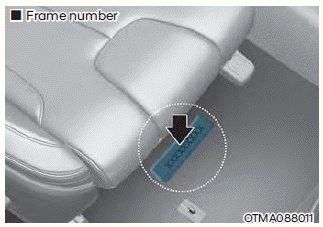Hyundai Santa Fe: Tire Pressure Monitoring System / TPMS Sensor. Repair procedures
Hyundai Santa Fe (TM) 2019-2025 Service Manual / Suspension System / Tire Pressure Monitoring System / TPMS Sensor. Repair procedures
| Replacement |
| 1. |
Remove the tire.
(Refer to Tires/Wheels - "Tire")
|
| 2. |
Remove the screw with torx driver (A).
|
| 3. |
Remove the sensor body (A) from the valve (B) in the direction of the
arrow.
|
| 4. |
Remove the valve using the valve mounting tool.
|
| 5. |
Apply lubricant to the surface of the valve, and then mount it through
the valve hole of the wheel.
|
| 6. |
Apply soapy water or lubricant to the upper/lower bead section of the
tire.
|
| 7. |
In order to mount lower the beads, place the TPMS sensor at 5 o'clock,
starting from the head of the tire replacement equipment.
|
| 8. |
Rotate the rim clockwise and press tire towards 3 o'clock to mount the
lower beads.
|
| 9. |
In order to mount the upper beads, press the tire towards 3 o'clock
and turn the rim clockwise.
|
| 10. |
Inject air into the tire until the beads are in the correct position.
|
| 11. |
Adjust the tire pressure according to the recommended tire pressure
for the vehicle.
|
| 12. |
If the TPMS sensor malfunctions, you must perform TPMS sensor learning.
Replace any faulty sensors and perform TPMS sensor learning.
|
| Diagnostic Procedure Using a Diagnostic Instrument |
The following section describes how to diagnose faults using a diagnostic instrument.
| 1. |
Connect the diagnostic instrument to the self-diagnostic connector (16-pin)
beneath the crash pad on the side of driver's seat, and then turn on
the ignition to activate the diagnostic instrument.
|
| 2. |
In the GDS Vehicle Type Selection menu, select "Vehicle Type" and "TPMS"
System, and then opt for "OK."
|
[Register Sensor Method]






|

[Sensor Status Method]





|

 TPMS Sensor. Description and operation
TPMS Sensor. Description and operation
Description
1.
Driving state
Sensor transmissions occur every 1 minutes and pressure is measured
every 15 seconds...
 TPMS Receiver. Description and operation
TPMS Receiver. Description and operation
Description
TPMS Receiver : BCM(body control module) integrated management
1.
Mode
(1)
Virgin State
•
The receiver as a sole part is shipped in this state...
Other information:
Hyundai Santa Fe (TM) 2019-2025 Service Manual: Troubleshooting
..
Hyundai Santa Fe (TM) 2019-2025 Owner's Manual: System malfunction and limitations
System malfunction When Rear View Monitor is not working properly, or the screen flickers, or the camera image does not display normally, we recommend that the system be inspected by an authorized HYUNDAI dealer. Limitations of the system When the vehicle is stopped for a long time in winter or when the vehicle is parked in an indoor parking lot, the exhaust fumes may temporarily blur the image...
Categories
- Manuals Home
- 4th Generation Santa Fe Owners Manual
- 4th Generation Santa Fe Service Manual
- Power adjustment
- Folding the side view mirror
- Engine Control System
- New on site
- Most important about car
Vehicle Identification Number (VIN). Vehicle certification label. Tire specification and pressure label
Vehicle Identification Number (VIN)

The vehicle identification number (VIN) is the number used in registering your vehicle and in all legal matters pertaining to its ownership, etc.
The number is punched on the floor under the passenger seat. To check the number, open the cover.
Copyright © 2025 www.hsafe4.com














